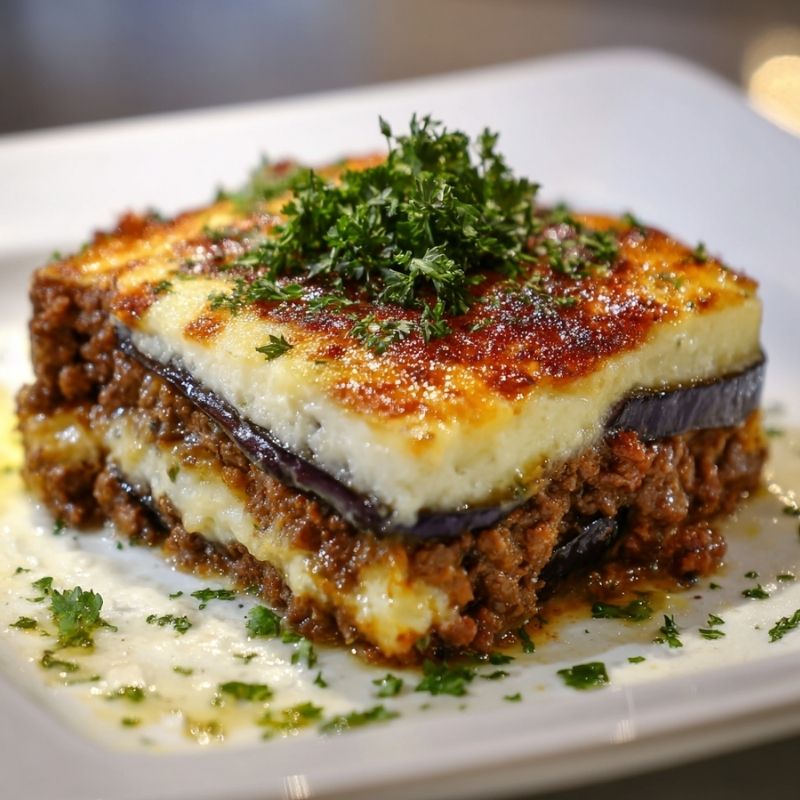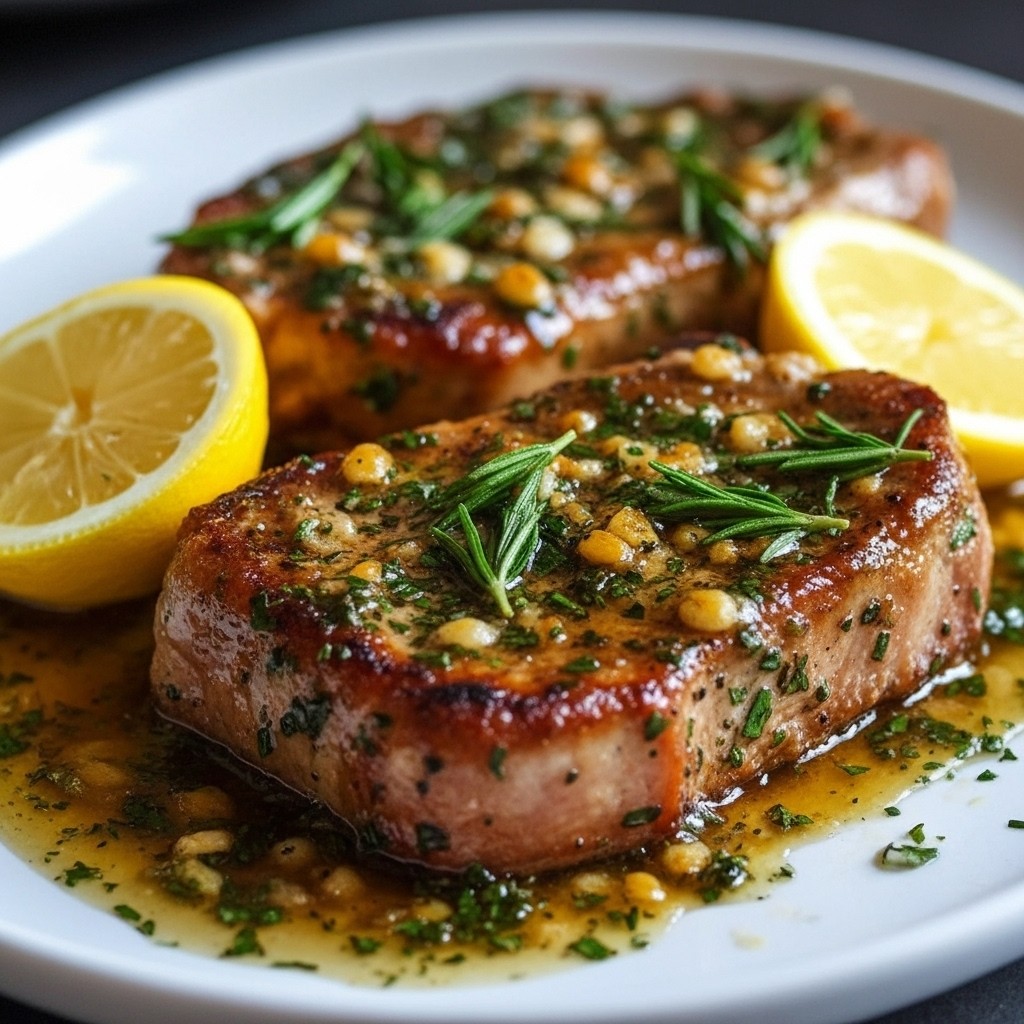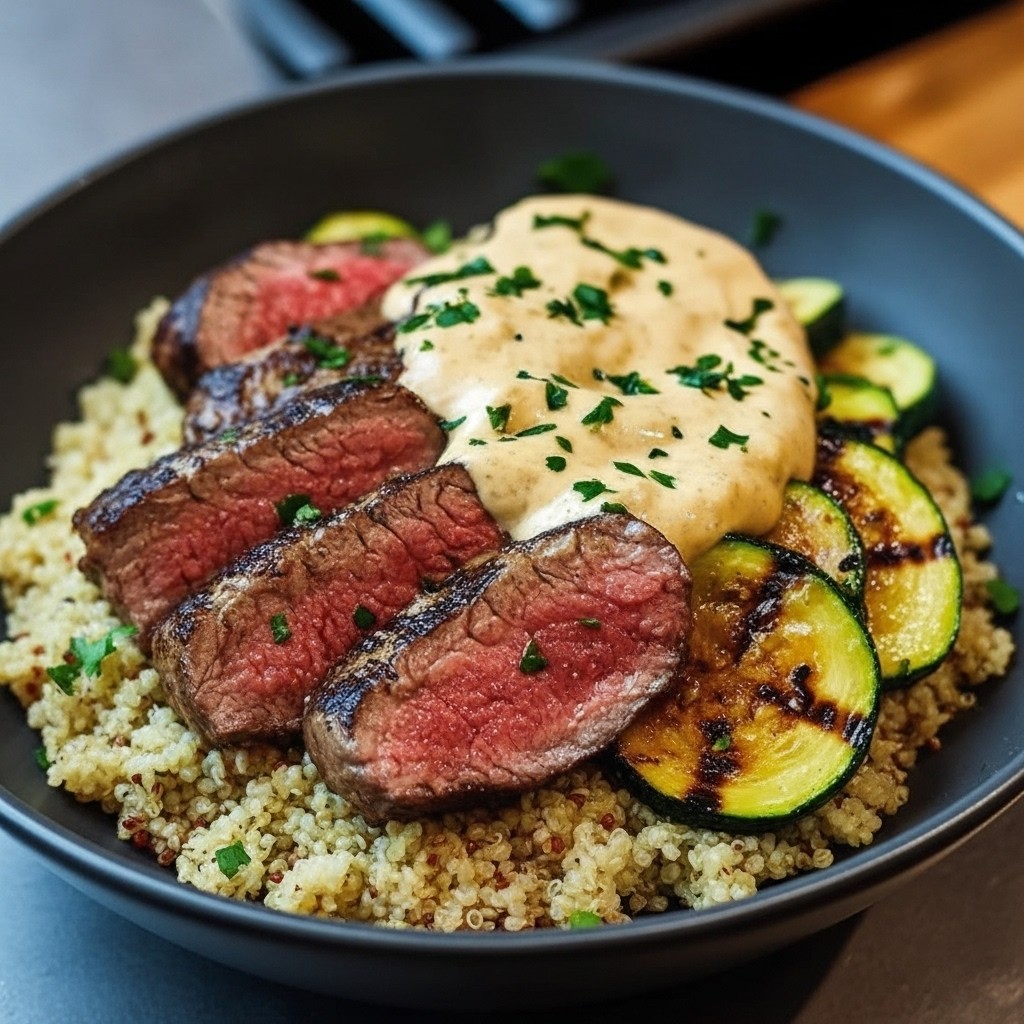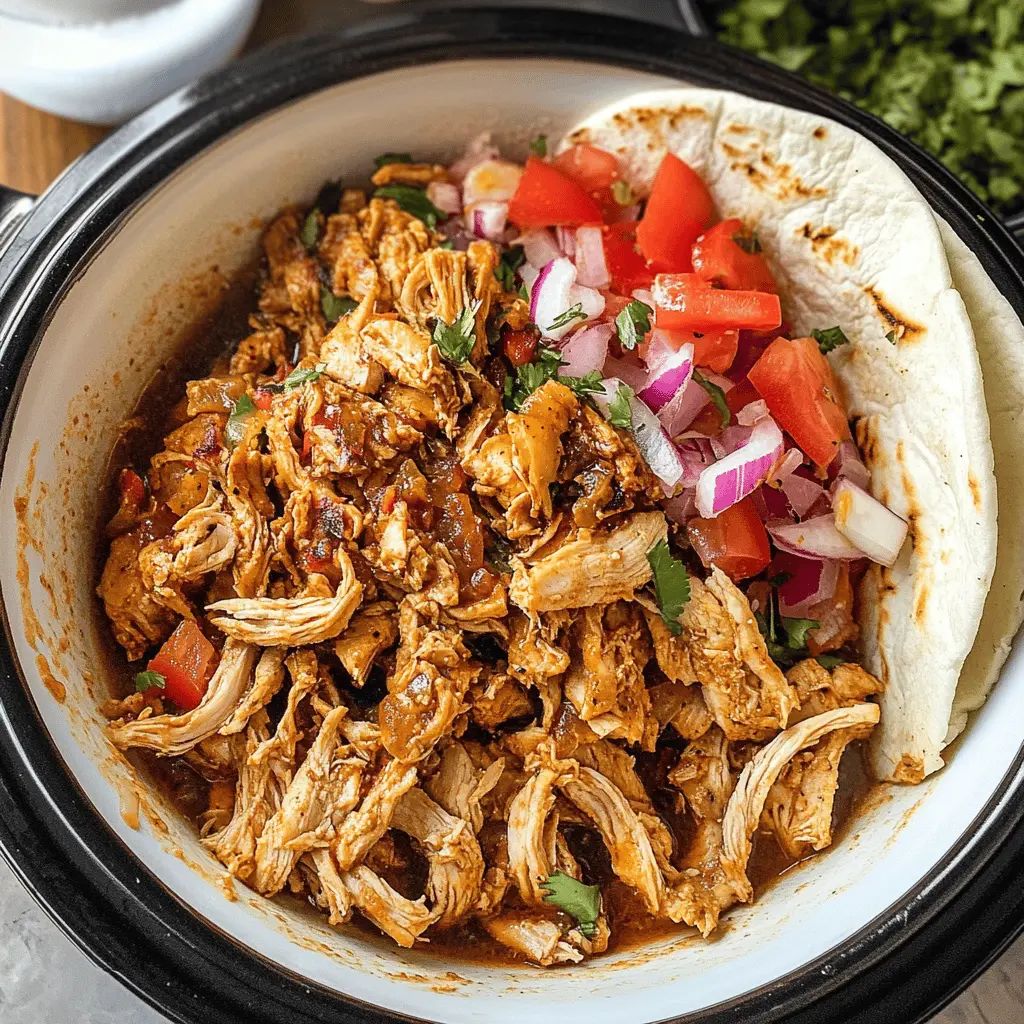Classic Greek Moussaka
On a recent Sunday, my kitchen was filled with the kind of quiet chaos I secretly enjoy: kids running in and out, the radio humming in the background, and a stack of fresh vegetables waiting on the counter. I had picked up shiny eggplants and zucchini from the weekend market, and they immediately reminded me of the layered comfort of a proper Greek moussaka. Making this dish feels almost like a ritual—it demands patience, but rewards you with something truly comforting.
As I sliced the vegetables, I remembered a meal years ago at a small taverna in Athens, where the owner proudly served steaming plates of moussaka that carried the scent of cinnamon and nutmeg through the air. That flavor memory stayed with me, and now, when I make it at home, it brings that same warmth to my family’s table.
The process of frying vegetables, simmering a rich meat sauce with red wine, and whisking a creamy béchamel is as satisfying as the final dish. It’s a recipe that asks you to slow down, but in return, you get a pan of bubbling, golden perfection that makes the wait more than worthwhile.
Moussaka is a showstopper on any table, but it’s also deeply personal—every cook seems to have their own little twist. This is the version I’ve leaned on over the years, a balance of tender vegetables, flavorful beef, and a silky sauce that pulls it all together.

Short Description
Greek moussaka is a hearty, layered casserole of fried vegetables, spiced meat sauce, and creamy béchamel, baked until golden and bubbling. It’s a traditional Mediterranean comfort dish that feels indulgent yet wholesome.
Key Ingredients
Vegetable Base
- 2 cups olive oil for frying (varies by pan size)
- 4 potatoes
- 4 zucchini
- 4 eggplants
- 200 g Kefalograviera cheese, finely shredded (or Parmesan, kasseri, pecorino)
- 1 tbsp salt
- ½ tbsp pepper
Meat Sauce
- 2 tbsp olive oil
- 1 large red onion, finely chopped
- 1 medium garlic bulb, minced
- 1 kg beef mince
- 1 cup red wine
- 800 g crushed canned tomatoes
- 1 tbsp salt
- ½ tsp white pepper
- ½ tsp ground cinnamon
- ½ tsp ground nutmeg
- 2 tsp sugar
- ½ tsp thyme
- 1 tsp oregano
- 3 bay leaves
- 1 bunch fresh parsley, finely chopped
Béchamel
- 150 g unsalted butter
- 1 cup plain flour
- 1 litre milk
- 2 egg yolks
- ½ tsp nutmeg
- 250 g Kefalograviera cheese, finely shredded
Tools Needed
- Large skillet or frying pan
- Wire rack or paper towels for draining vegetables
- Large saucepan for meat sauce
- Medium saucepan for béchamel
- Baking dish (9×13 inch works well)
- Whisk, sharp knife, spatula
Cooking Instructions
Step 1: Prepare the Vegetables
Slice potatoes, zucchini, and eggplants into even disks. Heat olive oil over medium-high and fry each batch until golden. Drain on paper towels or a wire rack to remove excess oil. Spread vegetables out while draining so they don’t steam and soften too much.
Step 2: Make the Meat Sauce
In a large pot, heat olive oil and sauté onion and garlic until soft. Add ground beef and cook until browned. Pour in red wine and simmer about 3 minutes until mostly evaporated. Stir in crushed tomatoes, spices, sugar, and herbs. Add bay leaves and parsley, then simmer on low for 10 minutes. Remove bay leaves before assembling.
Step 3: Prepare the Béchamel
Melt butter in a saucepan, then whisk in flour until smooth. Slowly add milk while whisking to prevent lumps. Cook until thick and creamy. Stir in egg yolks, nutmeg, and shredded cheese. Keep whisking until smooth, then remove from heat.
Step 4: Assemble the Moussaka
Preheat oven to 165°C (fan-forced). In a baking dish, layer potatoes, then sprinkle with salt, pepper, and cheese. Add a layer of eggplant with seasoning and cheese, followed by zucchini, then another eggplant layer. Spread the meat sauce evenly over the vegetables. Top with béchamel, smoothing it to the edges.
Step 5: Bake and Rest
Bake for 40 minutes until the top is golden. Begin checking at 30 minutes to avoid over-browning. Let rest at least 30 minutes before slicing—this helps the layers hold together beautifully.
Why You’ll Love This Recipe
Comforting Layers: Tender vegetables, rich beef sauce, and creamy béchamel create a satisfying bite.
Make-Ahead Friendly: Assemble in advance and bake when ready.
Balanced Flavors: Subtle spice from cinnamon and nutmeg adds warmth without overpowering.
Crowd-Pleasing: Perfect for family gatherings, potlucks, or holiday meals.
Adaptable: Easily swap beef with lamb or use lighter cheese for a different twist.
Mistakes to Avoid & Solutions
Overcrowding the pan when frying vegetables: This causes sogginess. Fry in batches for crisp edges.
Not draining vegetables well: Excess oil makes the dish greasy. Use a rack or spread out on towels.
Lumpy béchamel: Always add milk gradually while whisking. If lumps form, strain before using.
Cutting too soon after baking: The layers collapse. Always let it rest at least 30 minutes.
Forgetting to season each layer: A pinch of salt and pepper between layers enhances flavor.
Serving and Pairing Suggestions
Serve warm with a crisp green salad and lemon vinaigrette.
Pair with crusty bread to soak up the sauce.
A glass of red wine like Merlot or Cabernet complements the richness.
Serve family-style for casual gatherings or plated for a more formal dinner.
FAQs
1. Can I make moussaka vegetarian?
Yes, substitute the beef with lentils or mushrooms for a hearty vegetarian version.
2. Can I use lamb instead of beef?
Absolutely, lamb gives a more traditional Greek flavor.
3. Why let the moussaka rest before serving?
Resting helps the layers set, so slices hold their shape instead of collapsing.
4. Can I prepare moussaka ahead of time?
Yes, assemble up to a day in advance and bake before serving.
5. What’s the best cheese substitute if I can’t find Kefalograviera?
Parmesan, pecorino, or kasseri work well.
Tips & Tricks
Brush eggplant slices with olive oil before frying for even browning.
Use freshly grated cheese for the béchamel, it melts more smoothly.
Simmer meat sauce a bit longer for deeper flavor if you have time.
A pinch of cinnamon in the béchamel adds extra warmth.
Recipe Variations
Vegetarian Moussaka: Replace meat with sautéed mushrooms and lentils. Follow the same layering steps.
Lightened-Up Version: Roast vegetables instead of frying to reduce oil.
Cheese Twist: Use mozzarella and Parmesan for a more Italian-style flavor.
Mini Moussakas: Assemble in ramekins for individual portions—perfect for dinner parties.
Spicy Moussaka: Add chili flakes to the meat sauce for extra heat.
Final Thoughts
Making moussaka isn’t something you rush, and that’s what makes it special. The act of layering each ingredient, waiting for the sauce to simmer just right, and pulling a bubbling dish out of the oven feels grounding in the best way. Sharing it around the table turns dinner into an experience, not just a meal. The rich aroma of cinnamon, nutmeg, and roasted vegetables lingers long after the plates are cleared, reminding you why it was worth the effort.
This dish has a way of slowing everyone down, inviting conversation and second helpings. Whenever I make it, I feel like I’ve carried a little piece of Greek tradition into my own home, and that connection makes every bite taste even better.
Classic Greek Moussaka
Course: Main CourseDifficulty: Easy8
servings40
minutes1
hourGreek moussaka is a hearty, layered casserole of fried vegetables, spiced meat sauce, and creamy béchamel, baked until golden and bubbling. It’s a traditional Mediterranean comfort dish that feels indulgent yet wholesome.
Ingredients
- Vegetable Base
2 cups olive oil for frying (varies by pan size)
4 potatoes
4 zucchini
4 eggplants
200 g Kefalograviera cheese, finely shredded (or Parmesan, kasseri, pecorino)
1 tbsp salt
½ tbsp pepper
- Meat Sauce
2 tbsp olive oil
1 large red onion, finely chopped
1 medium garlic bulb, minced
1 kg beef mince
1 cup red wine
800 g crushed canned tomatoes
1 tbsp salt
½ tsp white pepper
½ tsp ground cinnamon
½ tsp ground nutmeg
2 tsp sugar
½ tsp thyme
1 tsp oregano
3 bay leaves
1 bunch fresh parsley, finely chopped
- Béchamel
150 g unsalted butter
1 cup plain flour
1 litre milk
2 egg yolks
½ tsp nutmeg
250 g Kefalograviera cheese, finely shredded
Directions
- Slice potatoes, zucchini, and eggplants into even disks. Heat olive oil over medium-high and fry each batch until golden.
- Drain on paper towels or a wire rack, spreading vegetables out so they don’t steam and soften too much.
- In a large pot, heat olive oil and sauté onion and garlic until soft. Add ground beef and cook until browned. Pour in red wine and simmer about 3 minutes until mostly evaporated.
- Stir in crushed tomatoes, spices, sugar, and herbs. Add bay leaves and parsley, then simmer on low for 10 minutes. Discard bay leaves before assembling.
- Melt butter in a saucepan, then whisk in flour until smooth. Slowly add milk while whisking to prevent lumps. Cook until thick and creamy. Stir in egg yolks, nutmeg, and shredded cheese. Whisk until smooth, then remove from heat.
- Preheat oven to 165°C (fan-forced). In a baking dish, layer potatoes, then sprinkle with salt, pepper, and cheese.
- Add a layer of eggplant with seasoning and cheese, followed by zucchini, then another eggplant layer. Spread the meat sauce evenly over the vegetables. Top with béchamel, smoothing it to the edges.
- Bake for 40 minutes until the top is golden, checking from 30 minutes to avoid over-browning. Let rest at least 30 minutes before slicing so the layers hold together beautifully.





